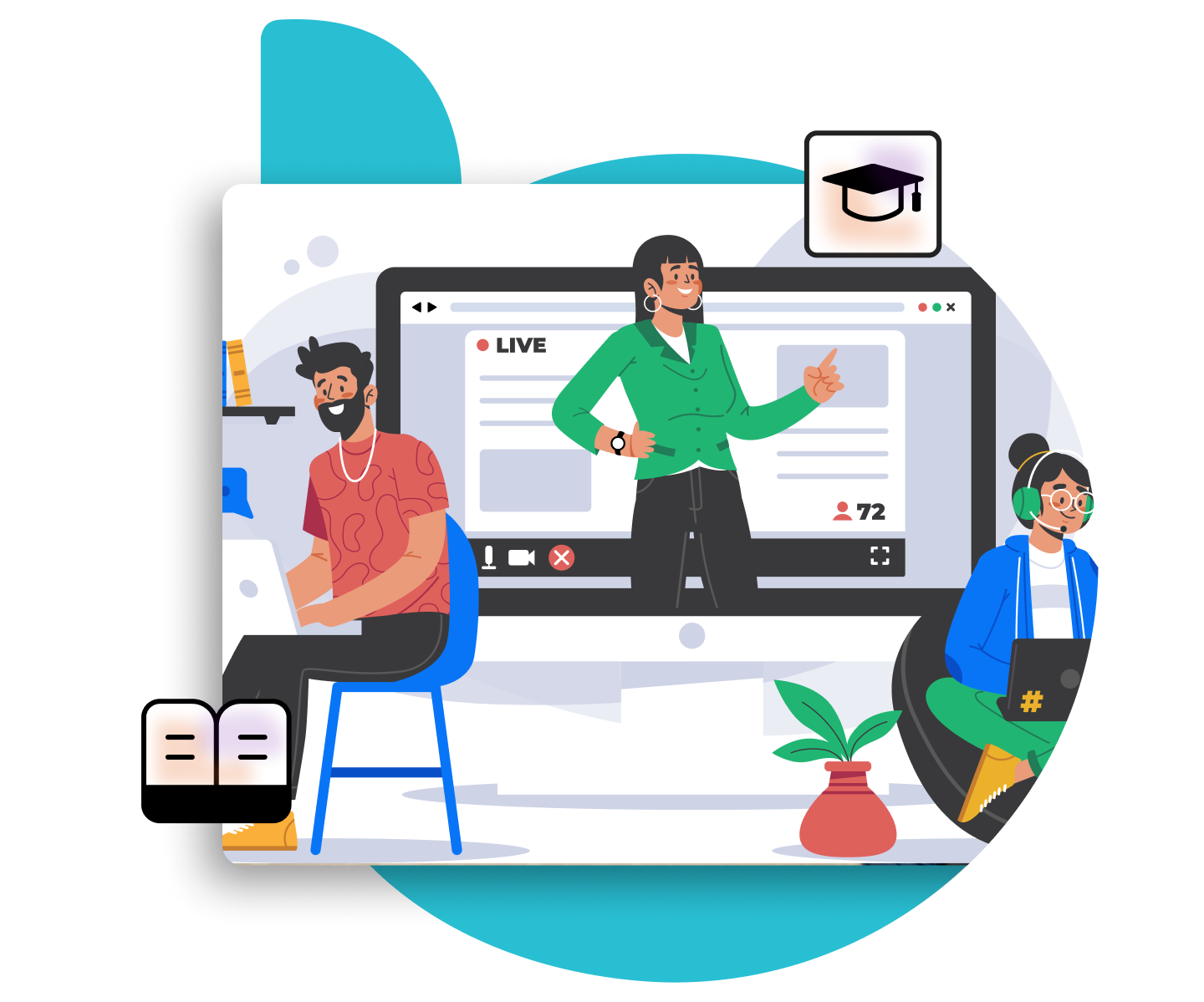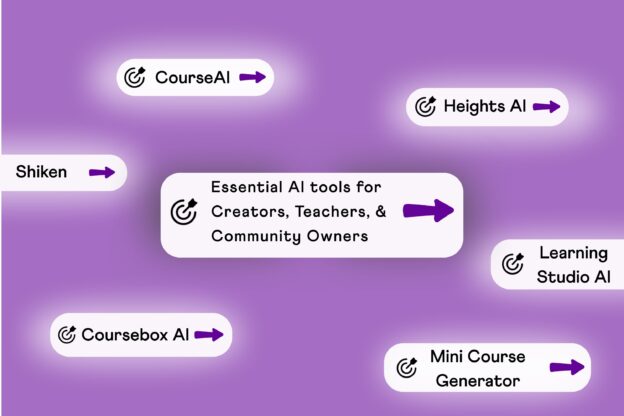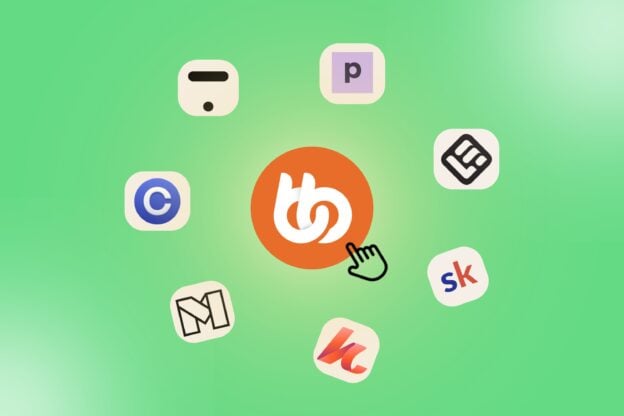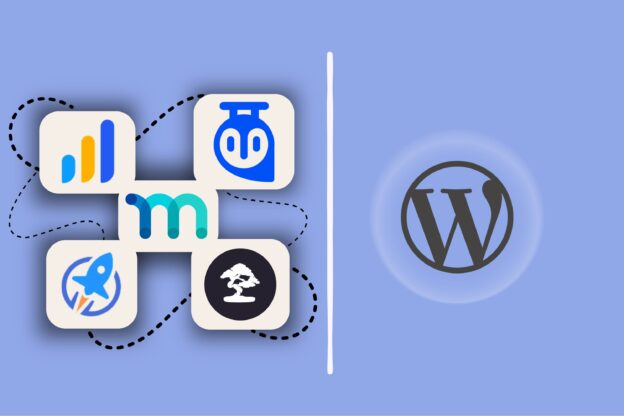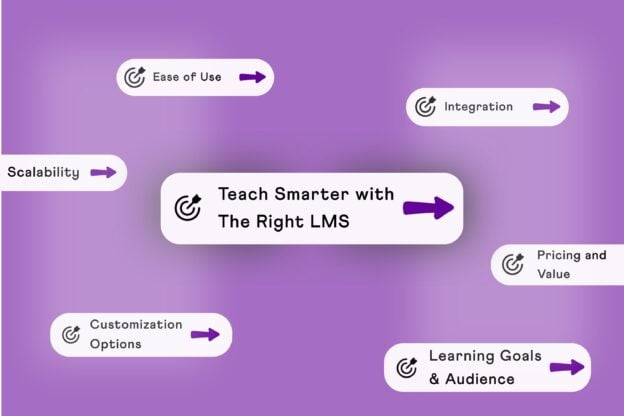Did you know that the average completion rate of online courses hovers around just 10%? Online learning has not only made education easier, but it also brought a lot of choices in front of learners. So unless you can create effective course content that truly helps learners achieve their learning goals, your course will not succeed. As you can guess, you need a sophisticated approach to create content for a successful course. This is where the B.A.N.K concept comes in.
The B.A.N.K. concept specifies the four essential types of online course content: Blueprint (Strategic content), Action (Tactical content), Nurturing (Supportive content), and Knowledge (Informative content). All four types of content need to be present in a course sequentially and cohesively.
In this article, we will explore the four types of online course content and how you can incorporate them into an online course to enhance learners’ experience.
Blueprint Content

An online course’s blueprint content serves as the course’s introduction and gives students a strategic overview of what to expect. It helps learners with the learning process by giving them a clear understanding of the online course content structure and objectives.
Importance of Blueprint Online Course Content
Blueprint content plays a crucial role in online learning because it provides a clear and concise overview of the online course content structure, objectives, and the big picture. Here are the main importance of blueprint content:
Helps learners understand the course structure and objectives
blueprint content helps learners understand what the course is all about and what they can expect to learn. This is important because learners are more likely to be engaged and motivated if they have a clear understanding of the online course content structure and objectives. They can then plan their time and allocate resources more effectively to achieve their learning goals.
Provides a roadmap for the course
Blueprint content serves as a roadmap that helps learners navigate through the course. By having a clear and detailed blueprint of the course, learners can better manage their learning process and track their progress. They can see what they have already covered, what they still need to learn, and how they can accomplish the objectives of the course.
Helps learners understand the big picture
Blueprint content serves as a roadmap that helps learners navigate through the online course content. By having a clear and detailed blueprint of the course, learners can better manage their learning process. They can also track their progress. They can see what they have already covered, what they still need to learn, and how they can accomplish the objectives of the course.
Examples of Blueprint Core Content
Let’s go through some examples of core blueprint content that you can utilize on your course as needed.
- Walkthrough video, chart, or diagram – A walkthrough video, chart, or diagram outlining the various stages of the course is one way to create effective blueprint content. This kind of visual representation can help students in comprehending the online course content’s overall organization and the material they can expect to learn. To ensure that students can refer to this material throughout their learning process, it’s important to make it readily available and easy to access at the start of the course.
- Overview of the course structure, stages and objectives – Another effective form of blueprint content is an overview of the course structure, stages, and objectives. This information helps students in comprehending the structure of the online course content and the learning outcomes. It could be a written report or an introductory video.
- Step by step guide to the process – This kind of material is especially beneficial for courses where students must complete tasks or projects. A step-by-step guide can assist students in breaking the procedure down into manageable steps, which makes it simpler for them to understand and put what they’ve learned into practice.
- Visual representation of the key concepts – Core blueprint content can be a visual representation of the key ideas being covered. The key concepts and connections between them can be outlined in an infographic, mind map, or concept map. For students who struggle with text-based material or are visual learners, visual representations can be especially helpful.
Examples of Blueprint Supplementary Content
For learners to better understand the course, supplemental blueprint content can be made available in addition to the core blueprint content. Below are examples of some supplementary blueprint content.
- Flowchart with Key decision Points and action items: A flowchart of the key decision points and action items is an excellent example of this type of content. This kind of information can assist learners in understanding their options and visualizing the decision-making process.
- Learning path diagram or chart – Another type of supplemental blueprint content is a diagram or chart that shows the learning path. As students progress through the course, this kind of content can help them keep track of their progress, inspiring them and giving them a sense of accomplishment.
- Step-by-step guide to the course process in PDF format – A step-by-step PDF guide is another example of supplemental blueprint content. Learners can download this kind of content and use it as a resource as they progress through the course. It can also be used by students who just need a quick refresher on what they’ve learned as a useful reference tool.
- Downloadable or interactive infographic with course structure and objectives – Interactive infographic that shows the goals and structure of the course is a good example of supplementary blueprint content. The learning process can be made more enjoyable and interactive by using this kind of content to engage students.
- Mind map or concept map outlining the key concepts – Finally, Another example of supplementary blueprint content is a mind map or concept map that showcases the main concepts of the course and their connections. This type of content can help learners see the big picture of what they’re learning and how different concepts are related to each other.
Action Content

Action content refers to the hands-on exercises and interactive activities that are designed to help learners apply what they have learned in a practical and tangible way. This kind of content increases learner engagement and motivation while giving them opportunities to put their knowledge and skills into practice.
Importance of Action Online Course Content
Action content is a vital component of an effective online learning course as it provides learners with hands-on exercises and interactive activities that can help them apply what they have learned in a practical and tangible way. Here are some of the key reasons why this type of online course content is so important:
Provides hands-on exercises and interactive activities: By offering hands-on exercises and interactive activities, action content enables learners to put theory into practice. It provides them with the opportunity to apply what they have learned in real-world scenarios, which can help to reinforce their understanding and retention of the material.
Helps learners apply what they have learned in a practical and tangible way: Action content is particularly important for learners who may be new to a subject or who are trying to learn complex or abstract concepts. These learners need the opportunity to practice what they have learned and see how it applies in a real-world context. Action content provides this practical application, helping learners to make connections between the theory and the reality of the subject matter.
Enhances engagement and motivation: Action content can be fun and engaging, which can help to increase learners’ motivation to continue with the course. It can also help to break up the monotony of reading or listening to lectures, making the learning experience more interactive and enjoyable. When learners are actively engaged with the material, they are more likely to retain what they have learned and apply it in their lives or work.
Examples of Action Core Content
There are many different types of action content that educators can incorporate into their online courses.
Here are some examples of action core content:
- Hands-on exercises and interactive activities: These activities can take the form of interactive tests, simulations, and games that give students a fun and interesting way to put what they have learned into practice.
- Worksheets and templates: Resources like these give students a step-by-step framework to solve a real-life problem. They can be used to help students in practically developing their knowledge and skills.
- Video tutorials and demos: These kinds of content are especially beneficial for students who learn best visually. They give detailed instructions on how to carry out particular tasks, which makes it simpler for students to put what they have learned into practice.
- Real-life case studies and examples: They also give students examples of how the ideas they are learning can be used in the real world. This may contribute to the learning becoming more applicable and meaningful.
- Group projects and collaborative activities: Another example of action content is group projects and collaborative activities. These kinds of exercises can be especially beneficial for students who enjoy cooperating in teams. They give students the chance to put what they have learned into practice by collaborating to find solutions to problems in the real world.
Examples of Action Supplementary Content
In addition to core action content, there are also many different types of action supplementary content that educators can incorporate into their online courses. Here are some examples:
- Quizzes and assessments: This is one of the prime examples of action supplementary content. Learners can use these resources to assess and internalize their knowledge. Additionally, they can be used to give feedback on how well students are advancing through the program.
- Gamification points, badges, or awards: This is another example of effective action supplementary content. These kinds of resources can be used to inspire students by giving them a sense of accomplishment as they advance through the curriculum.
- Leaderboards: This is a great example of action supplementary content. By letting students see how they are doing in comparison to their peers, these resources can be used to promote healthy competition.
- Virtual simulations or games: These kinds of resources can help students apply their newly acquired knowledge in a safe and controlled environment by allowing them to experience real-life scenarios virtually.
- Access to a library of relevant tools, software, and templates: This is a very important type of action content. These kinds of content can be used to give students the equipment they need to finish the hands-on exercises.
Nurturing Content

Nurturing content refers to the supportive and engaging materials and activities that are designed to help learners achieve their learning goals. This type of content is not exactly focused on providing new information but on creating an encouraging environment for learners to thrive in. Nurturing content includes personalized feedback, coaching, mentoring, a collaborative community, and other interactive activities that support learners’ progress and achievement.
Importance of Nurturing Online Course Content
Nurturing content is essential in online learning for several reasons:
Provides Personalized Feedback and Coaching: Nurturing online course content helps learners receive personalized feedback and coaching that is tailored to their specific needs. This feedback is critical in ensuring that learners understand the concepts they are learning, and it can also help identify areas where they need to improve.
Supports Learners with a Community of Peers and Mentors: Nurturing content fosters a sense of community among learners, which is crucial for their motivation and engagement. A supportive community of peers and mentors can offer learners the encouragement and guidance they need to stay on track with their studies.
Encourages Learners to Stay Engaged and on Track: Nurturing content helps learners stay engaged and motivated in their studies. By providing them with relevant and interesting material, learners are more likely to stay on track and complete their courses. Additionally, nurturing content helps learners see the relevance and applicability of what they are learning, which can increase their motivation and engagement.
Examples of Nurturing Core Content
The following are examples of nurturing core content that can be included in online courses:
- Pre-course survey or questionnaire: A good example of core nurturing content is pre-course survey. They can help students in sharing their backgrounds and learning goals, enabling course designers to customize the course to the students’ particular needs.
- 1:1 Coaching sessions: Individualized support can be given to students during private coaching sessions, allowing them to receive tailored advice and feedback on their development. This is another example of core nurturing content.
- Personalized feedback: Personalized feedback can also be specified as a type of nurturing content. Giving students individual feedback on their assessments or work from lessons can help them understand their progress and what they need to concentrate on.
- Q&A sessions: This is another great example of helpful nurturing content. Live Q&A sessions with subject matter experts or mentors can give students the chance to ask questions and get immediate responses, which can help them understand the course material better.
Examples of Nurturing Supplementary Content
The following are examples of nurturing supplementary content that can be included in online courses:
- Peer mentoring or buddy program – This is an effective form of nurturing supplement content. Students can connect with and learn from one another through a peer mentoring or buddy program, which can also offer more encouragement and motivation.
- Private discussion forum – Learners can feel safe asking questions, talking about their experiences learning, and getting support from peers and mentors in a private discussion forum.
- Supportive community – A supportive community is a great example of nurturing supplementary content. The likelihood that students will finish their courses increases when they feel more connected and engaged in their learning environment.
Knowledge Content

Knowledge content is the type of content that offers students the foundational knowledge, information, and skills necessary for learners to understand the course’s subject matter. Knowledge content is the main type of content of a course, as it includes lessons, presentations and lectures from the teacher.
Importance of Knowledge Online Course Content
Knowledge content is the primary content of an online course and their importance is immense. Below are some of the reasons they are important –
- Provides the foundational knowledge and information: Knowledge content is important because it serves as the cornerstone on which students can expand, refine, and apply their skills. The background information gives students the necessary context and comprehension of the subject. Learning the more complex concepts can be difficult for students without this background information.
- Expands learners’ understanding: They help students to build a solid understanding of the subject matter. The more students go through the knowledge content, the better they can see the connections between different concepts and ideas, making it easier for them to apply what they have learned to real-world problems.
- Helps learners build the necessary skills and competencies: Finally, knowledge content that is covered in an online course gives students the ability to apply what they have learned. It helps students gain a solid foundation in the subject matter as well as the necessary critical thinking and problem-solving skills.
Examples of Knowledge Core Content
Below are some examples of core knowledge content that you might want to utilize in your course.
- Lessons, presentations or lectures from the expert: Lessons, presentations, or lectures from the expert are the most common examples of knowledge content. Experts deliver content in a way that is easy to understand, engaging, and provides learners with the necessary context to understand the subject matter.
- Study materials, such as articles, audio lessons, whitepapers, and ebooks: These resources give students more information to delve deeper into the subject. They enable students to learn more about a subject by going beyond the fundamentals.
- Case studies: Case studies provide real-life examples of how the knowledge can be applied to different situations, making it easier for learners to understand the practical applications of the concepts.
Examples of Knowledge Supplementary Content
Access to relevant research and data to support learning: One example of knowledge supplementary online course content is the relevant research and data that facilitates learning. These kinds of content let learners have access to additional resources to explore the subject matter in-depth. It allows learners to develop a deeper understanding of the concepts and provides them with additional insights into the topic.
Explanations and definitions or glossary of key terms and concepts: Glossaries and definitions is another example of knowledge supplementary content. These are useful for students to have at their disposal because they make it simpler for students to comprehend the subject matter by giving concise and clear explanations of important terms and concepts.
References, additional or further reading, citations, and links to resources: These types of resources provide learners with additional materials to explore the topic further. They help learners broaden their knowledge base and dive deeper into the subject matter to enhance their understanding of the topic.
Frequently Asked Questions (FAQs)
Explore these frequently asked questions to gain deeper insights and practical tips about effectively utilizing the B.A.N.K. concept in your online course content creation. These answers are designed to clarify common queries and enhance your understanding of the course structure and its components.
What makes the B.A.N.K. concept unique in online course content creation?
The B.A.N.K. concept uniquely categorizes course content into four essential types – Blueprint, Action, Nurturing, and Knowledge – each tailored to enhance the learning experience by addressing different aspects of learner engagement and comprehension.
How does Blueprint content improve online learning?
Blueprint content provides learners with a clear and structured overview of the course, setting expectations and goals upfront, which helps in better planning and engagement with the course material.
Can Action content in online courses really enhance practical learning?
Yes, Action content involves hands-on exercises and interactive activities that enable learners to apply theoretical knowledge in practical scenarios, thereby enhancing understanding and retention of the material.
What role does Nurturing content play in an online course?
Nurturing content supports learners through personalized feedback, mentoring, and community engagement, which is crucial for keeping them motivated, on track, and feeling supported throughout their learning journey.
Why is Knowledge content considered the backbone of online courses?
Knowledge content forms the foundation of online courses, providing essential information and skills that are necessary for understanding the subject matter deeply and forming a basis for advanced learning and application.
Conclusion
In conclusion, effective online course content creation is critical to ensuring learners have a positive and impactful learning experience. Incorporating the four types of content – Blueprint, Action, Nurturing, and Knowledge (B.A.N.K.) – can help create a balanced and engaging online learning experience that supports learners in achieving their objectives.
By providing learners with a clear understanding of the course structure, practical exercises and activities, personalized feedback and coaching, and foundational knowledge, learners can develop the skills and competencies they need to succeed. By leveraging the B.A.N.K. framework, instructors and course designers can create online courses that deliver meaningful and lasting value to their learners.

